WHAT'S NEW ACROSS THE WORLD
Select date in side bar to go a What's
New of previous issues
| What's New ©by
Laif DeMason
From time to time, we all take a moment to assess
the “big picture” of what we are doing and where life is taking us. Fish
keeping is a big part of most of our lives. I have always thought of cichlid
hobbyists as special people; dedicated individuals with a keen interest
in the care of their animals. Things have worked out for us, our generation,
but what about the next? Who will carry the cichlidophile torch? Maybe
it’s time for us to give something back to the hobby. Some of us are members
of local fish clubs. But that’s like preaching to the choir. Maybe you’re
also a member of other organizations, like Rotary, Lion’s, or Scouting.
Maybe you have kids in school or know a great fish store nearby. Donate
an aquarium set-up to your favorite social organization and volunteer some
time to show others how to work the magic. Or, talk a retailer into hosting
a class of kids for a tour, and volunteer to help supervise them. It will
be well worth your time. The future depends on it!
Here’s “what’s new” on the cichlid scene: |
Lake Tanganyika
Reports of heavy rains, poor visibility, and road closures around the
lake have filtered in at the time of this writing. However, collection
and exports still continue at the normal locations whenever possible. Interest
in Petrochromis species remains strong. Also noteworthy is the renewed
interest in the many varieties of Tropheus. Further interest in Cyprichromis
species and oddball Tanganyikan fish has also taken hold.
|
what's new: Lake Tanganyika
|
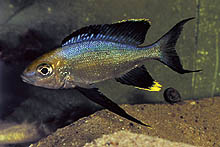
Hailing from the southern Kipili Bay area, this new
form of Cyathopharnyx furcifer sports yellow dorsal fin markings
and an orange cap. Photo by A. Konings. |
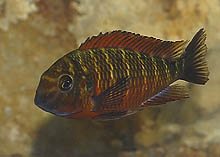
Imported many years ago, Tropheus moorii Ndole
has again piqued interest with its strong red coloration and markings.
This variety has a stronger red coloration than the closely-related Kachese
form which is more orange. |
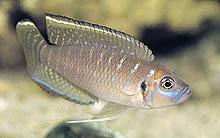
Collected in areas north of Kigoma, Tanzania, Lamprologus
brevis Katabe is available from bred sources again, along with other
popular shell-dwelling species. Photo by A. Konings. |

Several different species of Trematocara have
recently, and sparingly, been exported from Zambia. T. stigmaticum
is pictured here. Photo by A. Konings. |
Lake Malawi
Bad weather has also been reported from Lake Malawi. Heavy rains and
reduced visibility have temporarily halted collections in some places.
Some of the specialized groups of haplochromines have stimulated interest
and demand for Malawi fans. Many of the Protomelas species, including the
steveni-types, and other predatory haplochromines have found favor as of
late. Color and size considerations seem to be driving these choices.
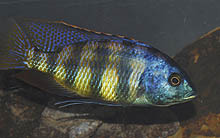
Occasionally imported (as “Barred Steveni”), Placidochromis
sp. “solo” becomes very colorful once settled in. This species still arrives
from Tanzania in small numbers and is also available as F1 fry from breeders. |
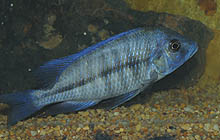
Commonly bred on Florida fish farms for years, Protomelas
annectens has now all but disappeared from commercial institutions.
Wild specimens (photo) are rarely seen in shipments from Tanzania. |
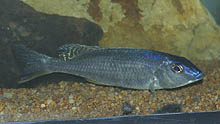
This torpedo-shaped predator hails from the extreme
northern end of the lake. It is called Otopharnyx sp. “torpedo blue”
from Itungi Port, Tanzania. |
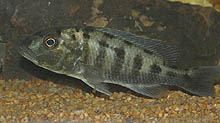
Found around the lake, Buccochromis heterotaenia
is a strongly-barred predator “hap” that appears infrequently on export
lists. |

A recent arrival from Tanzania (and always in low
numbers), this Pseudotropheus crabro sports delicate blue and yellow
markings over the usual brownish barring. It was called “Bumblebee Ornatus”
and “Chameleo” in the past. |

Previously known as a member of Pseudotropheus,
this attractive species from Chitimba Bay, Malawi, is actually a Cynotilapia:
C.
sp. “elongatus chitimba.” Photo by A. Konings. |
West Africa
The collecting season is now in full-swing. Some of the established
exporters in two countries have pulled out of the business, indicating
a lack of demand for the well-known riverine species from the Congo. Another
problem may be the presence of too many players in some countries, e.g.,
Cameroon. Still, there is no shortage of individuals willing to export
tropical fish from these areas.
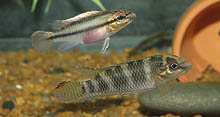
Gabon remains an undiscovered country for most hobbyists.
Its unique cichlids, like this pair of Parananochromis ornatus,
must be collected by dedicated enthusiasts if they are to be kept in aquaria.
Photo by A. Bornstein. |
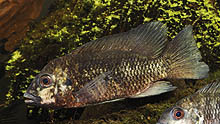
Some of the smaller Tilapia species from Lake
Bosumtwi in Ghana are sporadically available. Their size makes them interesting
candidates for the aquarium. Pictured here is the unique T. discolor.
Photo by O. Lucanus. |
Neotropics
Selections of Neotropical cichlid species continue to increase. Not
only does Man invent more color varieties of the well-known, like discus
and angelfish, but new, natural color forms of species from different locales
continue to appear for the real connoisseurs! Thankfully, some old-time
favorites, inbred for generations, can still be collected from the wild
if one wants to start anew.
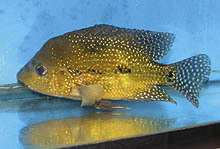
Wild-caught Nicaraguan cichlids have rarely been exported.
Pictured here, a wild Amphilophus rostratus provides a unique opportunity
to re-establish an old favorite with “fresh” genes. Photo by J. Rapps. |
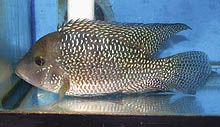
Another old favorite, Geophagus brasiliensis,
is frequently exported. Breeders can thus select the best-colored individuals
for production of offspring. Photo by J. Rapps. |

This red-sided, thick-lipped species of Heros
has been recently imported from the Columbian Amazon. It is likely yet
another new severum-type. Photo by O. Lucanus. |
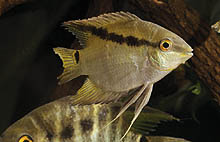
Another Columbian import, Mesonauta egregius
is one of two new Mesonauta species from the area. Photo by O. Lucanus. |
Select date in side bar to go a What's
New of previous issues
|















